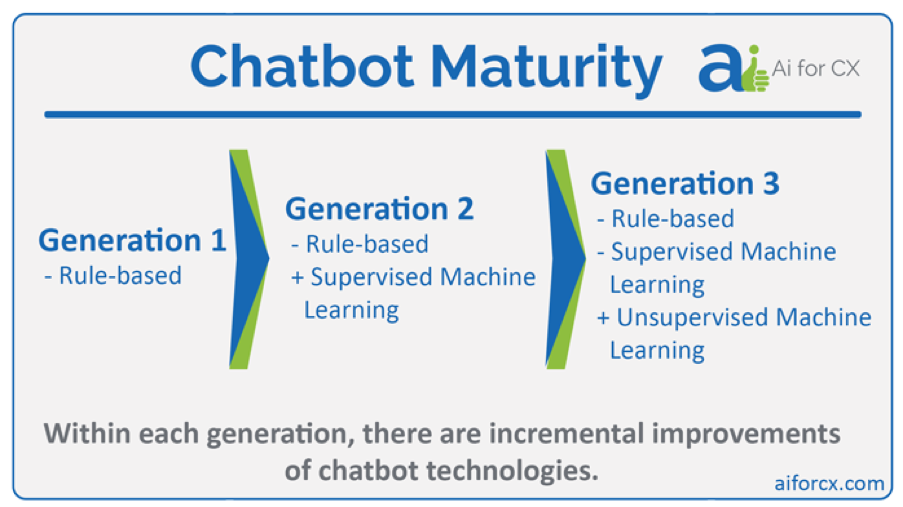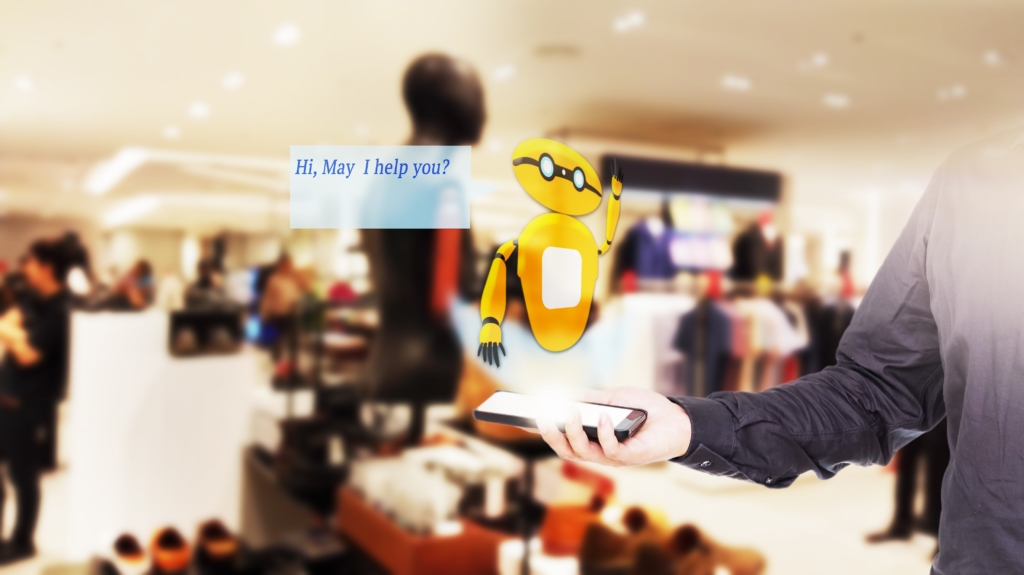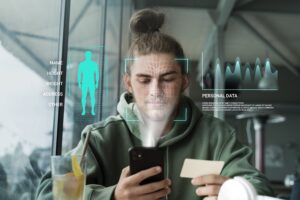In today’s economy, there are two things that you must do. You must deliver a customer experience (CX) that is uniquely differentiated AND you must successfully execute a digital transformation.
When digital transformation and a CX focus are intertwined, the combination leads to disruption.
A select set of organizations know this to be so important that instead of undertaking the daunting task of trying to convert their legacy organization, they go and launch a brand-new organization. Why? Because it’s very hard to change what they have been doing for decades.
Conducting a conversation is an extremely difficult task for humans to manage. This is one of the main reasons chatbots misunderstand, or are unable to understand you.
With a 1st Generation chatbot the range of conversation is very limited to a specific use case. The chatbot designer creates a very simple conversation flow. For example, a simple password reset can be handled easily.
Moving on to customer interactions that generate greater business impact and time savings for customers, more linguistically advanced chatbots in the 2nd and 3rd generation conduct natural language processing – often referred to as “NLP”.
The approaches to NLP vary. This variance often separates the 2nd and 3rd Generation of bots. These later generations are where Conversational Artificial Intelligence becomes available. This is where big business and customer value can be experienced.
Please Share:
You’re Not the Lucky One
But you probably do not have the luxury of starting from a new beginning. Like most of us, you’ve inherited the responsibility to lead the organization in CX. And if you’re like so many CX leaders, you struggle to get buy-in with executives and getting people to work cross-functionally. Many CX programs have come under a lot of scrutiny because of the perception of low value. But you can increase your value and the value of your CX program when you take on the digital transformation effort. It’s a lot easier for people to see the tangible impacts to the business when significant efficiencies are gained through digital transformation. Digital transformation also has significant CX impacts as well. Customers are growing more digitally sophisticated each and every day. Their expectations in CX from the companies or brands they interact with is being raised as well. So, it’s very important for you to learn how different technologies can be used to transform and enhance CX.The Foundational Technology
The technological core of a more digitally-focused CX is the artificial intelligence-based chatbot. The growth of mobile has put your customers in the “digitally-demanding” position. You now need to support customers across multiple, interconnected devices and channels. And customers also demand that you’re always on and available to support them, with no waiting. The AI chatbot is the only way you can efficiently serve your digitally-demanding customers. But you need to understand chatbot technology to make sure you serve them effectively. The digital experience can’t be left to chance…or marketing hype. “Chatbot” can be a very generic term, like “car”. There’s a vast difference in the ability of chatbots, just like there’s a difference in the abilities of your front-line staff. Learning the difference is key to YOU delivering value.Types of Chatbot Technology
There’s fact, fiction, and all out fallacies in the chatbot marketplace today. To help keep your bearings and stay on the right path, knowing the different generations of chatbot tech will help you to navigate the confusing and crowded marketplace.- 1st Generation: Based on simple written rules. If the customer says this, the chatbot replies with this.
- 2nd Generation: Based on supervised machine learning. You need to label conversation data and try to train a model to learn how to talk with the customer. You need a lot of labeled data.
- 3rd Generation: Based on adaptive unsupervised learning. The AI chatbot can learn from unlabeled data. This generation generally combines the benefit of previous generations. It can use rules and labeled data and the ability to learn from many unlabeled data to handle more complex conversations.
 It’s not a simple thing
It’s not a simple thing
Conducting a conversation is an extremely difficult task for humans to manage. This is one of the main reasons chatbots misunderstand, or are unable to understand you.
With a 1st Generation chatbot the range of conversation is very limited to a specific use case. The chatbot designer creates a very simple conversation flow. For example, a simple password reset can be handled easily.
Moving on to customer interactions that generate greater business impact and time savings for customers, more linguistically advanced chatbots in the 2nd and 3rd generation conduct natural language processing – often referred to as “NLP”.
The approaches to NLP vary. This variance often separates the 2nd and 3rd Generation of bots. These later generations are where Conversational Artificial Intelligence becomes available. This is where big business and customer value can be experienced.
The Brain of your chatbot
The unfortunate reality is that many chatbot solutions are not capable of 3rd Generation performance because they lack a Dialog Manager. It’s the Dialog Manager that is the brain of the chatbot. It handles the conversation with humans. The Dialog Manager provides the ability to keep track of information relevant to the dialog, and decides what to do next in the dialog context. The decision may include asking the user for more input, clarification, or switch to a different task. A Dialog Manager assigns meaning to the words recognized by the NLU. If a response to the user is required, it will choose the words and phrases to be used in its response to the user, and transmit these.Making chatbot Work
The way solution providers make 2nd and 3rd Generation chatbots smarter is Machine Learning. Machine Learning is a subset of AI techniques that gives machines the ability to learn from data or while interacting with the world without being explicitly programmed. Machine Learning is what makes quick and accurate customer interactions possible. One of the most difficult machine learning project is building AI chatbots. Only a small number of organizations can build their own Machine Learning project that’s complex enough to support chatbot development. These are big-budget internal projects that require very special skill sets. Effective Machine Learning engineers with language processing and dialog management background are very rare.Types of Machine Learning
The goal is to approximate the mapping function of human language so well that when you have new input data (“Help”) that you can predict the output variables (“How may I assist you?”) for that data.The majority of chatbot solutions use Supervised Machine Learning only. Supervised Learning is where you have input variables (x) and an output variable (y) and you use an algorithm to learn the mapping function from the input to the output. Supervised Machine Learning requires a lot of labeling of data to teach the learning process. This teacher must help to identify the correct answer to deliver. Learning stops when the teacher stops teaching. Unsupervised Machine Learning is where you only have input data (x) and no corresponding output variables. Through unsupervised learning, the AI system learns about the regularities in the data by modeling the underlying structure or distribution in the data. These are called unsupervised because unlike Supervised Machine Learning, the AI system self improves by observing data, without requiring a teacher or data labelled with correct answers. A typical company usually already has a lot of unlabelled data to initiate the chatbot. Besides, the chatbot collects a lot of unlabelled conversational data over time. Unsupervised learning can improve the chatbot with these data. Unsupervised learning can be found in only a few chatbot solutions, but is highly desired because it reduces the amount of administration and maintenance needed to improve the customer experience by managing of the chatbot.Deep Learning
In the past 10 years, the best-performing artificial-intelligence systems, such as the speech recognizers on smartphones or Google’s latest automatic translator have resulted from a technique called “Deep Learning.” Deep Learning is a new name for an approach to artificial intelligence called neural networks. Deep Learning currently provides the best solution to many problems in speech recognition, and natural language processing. Deep Learning dramatically increases the performance of Unsupervised Machine Learning. The highest performing chatbots have deep learning applied to the NLU and the Dialog Manager.Elevating Demands
The marketplace is moving very fast and customer expectations and demands are rising every day. You need to learn this now. You need to know the reasons why chatbots fail and how to prevent it…now. That’s why I included this information and much more in infographic Starting a Successful Chatbot Program. You must keep moving down the right path in your journey by selecting the right chatbot technology. You can rule AI.Please Share:
- The Core of Your Digital Transformation in CX – Click to Tweet
- “As consumers shift their communication preferences and expect you to be always there for an answer, you have to use chatbots.” – Click to Tweet
- “Knowing the different generations of chatbot tech will help you to navigate the confusing and crowded marketplace.” – Click to Tweet






